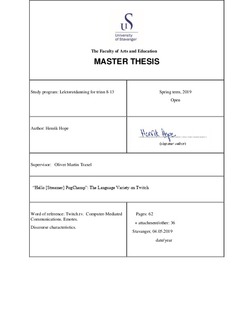"Hello [Streamer] PogChamp": The Language Variety on Twitch
Master thesis
Permanent lenke
http://hdl.handle.net/11250/2603065Utgivelsesdato
2019-05-04Metadata
Vis full innførselSamlinger
- Student papers (HF-IKS) [909]
Sammendrag
The present text is a research into the language usage in Computer-Mediated Communication, specifically on the online streaming platform Twitch.tv. The study will discuss Twitch’s language variety with a focus on Twitch emotes and discourse characteristics of a Twitch chat log. Studying Twitch emotes is the underlying method of this research as the thesis will attempt to distinguish meaning from the top 5 most used emotes on Twitch and try to establish the context to which these emotes occur. The focus group of this thesis is from selected livestreams that average between 30-500 viewers, characterized as a “participatory community”. Participatory communities are distinguished as communities that encourage openness and calls for its members to engage in shared activities, thus creating a shared identity and history online. With this focus group, the present study will conduct a qualitative survey regarding the participants’ perception of Twitch emotes and a Computer-mediated Discourse Analysis (CMDA) of the chat logs in order to find emote context, how emotes affect the participatory community and discourse characteristics of a Twitch chat. Conducting research on online behavior is often anecdotal or speculative; however, the approach to answering the research questions in this thesis was done by combining the participants’ perception of emotes and by analyzing and extracting a valuable answer from the chat log.
What the qualitative survey revealed was that the perception of emotes was varied, meaning it had more than just one mode of expression, yet its expressions were somewhat similar. By using the survey findings as framework for the chat log samples, the CMDA findings revealed that Twitch’s discourse characteristics had the same features as any other online medium, the context to which emotes occurred correlated with the participants’ perception of emotes, and that some emotes promoted others to respond whereas some emotes did not.
Beskrivelse
Master's thesis in Literacy studies
